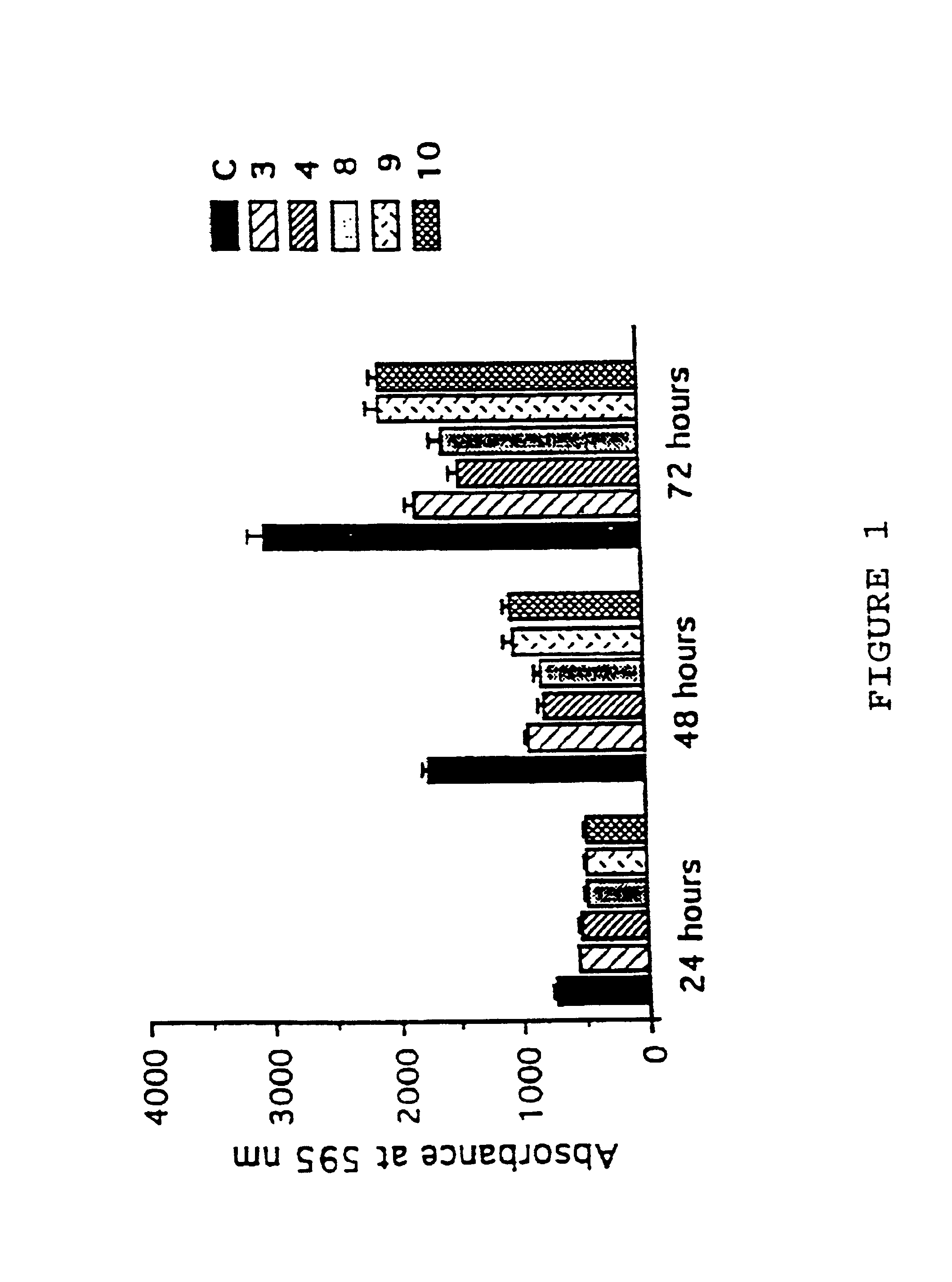Rat PTTG polypeptide and method for producing it
a polypeptide and rat technology, applied in the field of nucleic acids and proteins, can solve problems such as abnormal cellular proliferation and other problems
- Summary
- Abstract
- Description
- Claims
- Application Information
AI Technical Summary
Benefits of technology
Problems solved by technology
Method used
Image
Examples
example 1
Isolation of PTTG cDNA
[0110]To clarify the molecular mechanisms involved in pituitary tumorigenesis, differential display PCR was used to identify mRNAs differentially expressed in pituitary tumor cells (see, e.g., Risinger et al., 1994, Molec. Carcinogenesis, 11:13-18; and Qu et al., 1996, Nature, 380:243-247). GC and GH4 pituitary tumor cell lines (ATCC #CCL-82 and #CCL-82.1, respectively) and an osteogenic sarcoma cell line UM108 (ATCC #CRL-1663) were grown in DMBM supplemented with 10% fetal bovine serum. Normal Sprague-Dawley rat pituitaries were freshly excised. Total RNA was extracted from tissue cultured cells and pituitary tissue using RNeasy™ kit (Qiagen) according to manufacturer's instructions. Trace DNA contamination in RNA preparations was removed by DNase1 (GenHunter Corporation) digestion. cDNA was synthesized from 200 ng total RNA using MMLV reverse transcriptase (GenHunter Corporation), and one of the three anchored primers (GenHunter Corporation). The cDNA generat...
example 2
Characterization of PTTG cDNA
[0114]To characterize this pituitary tumor-specific mRNA further, a cDNA library was constructed using mRNA isolated from rat pituitary tumor cells. Poly A+RNA was isolated from pituitary tumor GH4 cells using messenger RNA isolation kit (Stratagene) according to manufacturer's instructions, and was used to construct a cDNA library in ZAP Express vectors (Stratagene). The cDNA library was constructed using ZAP Express™ cDNA synthesis and Gigapack III gold cloning kit (Stratagene) following manufacturer's instructions. The library was screened using the 396 bp differentially displayed PCR product (cloned into TA vector) as the probe. After tertiary screening, positive clones were excised by in vivo excision using helper phage. The resulting pBK-CMV phagemid containing the insert was identified by Southern Blotting analysis. Unidirectional nested deletions were made into the DNA insert using EXOIII / Mung bean nuclease deletion kit (Stratagene) following man...
example 3
In vitro Transcription & Translation of PTTG
[0118]Sense and antisense PTTG mRNAs were in vitro transcribed using T3 and T7 RNA polymerase (Stratagene), respectively. The excess template was removed by DNase I digestion. The in vitro transcribed mRNA was translated in rabbit reticular lysate (Stratagene). Reactions were carried out at 30° C. for 60 minutes, in a total volume of 25 μl containing 3 μl in vitro transcribed RNA, 2 μl 35S-Methionine (Dupond) and 20 μl lysate. Translation products were analyzed by SDS-PAGE (15% resolving gel and 5% stacking gel), and exposed to Kodak film for 16 hours.
[0119]The results indicate that translation of in vitro transcribed PTTG sense mRNA results in a protein of approximately 25 KD on SDS-PAGE, whereas no protein was generated in either the reaction without added mRNA or when PTTG antisense mRNA was utilized.
PUM
| Property | Measurement | Unit |
|---|---|---|
| temperature | aaaaa | aaaaa |
| temperature | aaaaa | aaaaa |
| volume | aaaaa | aaaaa |
Abstract
Description
Claims
Application Information
 Login to View More
Login to View More - R&D
- Intellectual Property
- Life Sciences
- Materials
- Tech Scout
- Unparalleled Data Quality
- Higher Quality Content
- 60% Fewer Hallucinations
Browse by: Latest US Patents, China's latest patents, Technical Efficacy Thesaurus, Application Domain, Technology Topic, Popular Technical Reports.
© 2025 PatSnap. All rights reserved.Legal|Privacy policy|Modern Slavery Act Transparency Statement|Sitemap|About US| Contact US: help@patsnap.com

